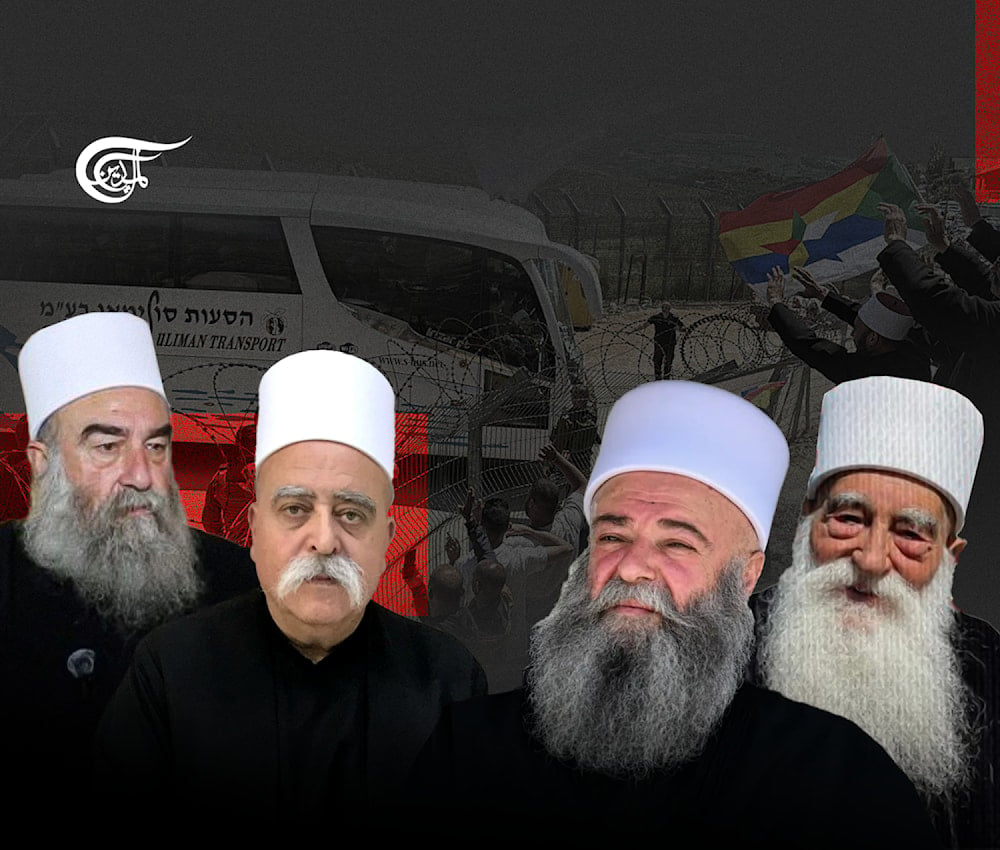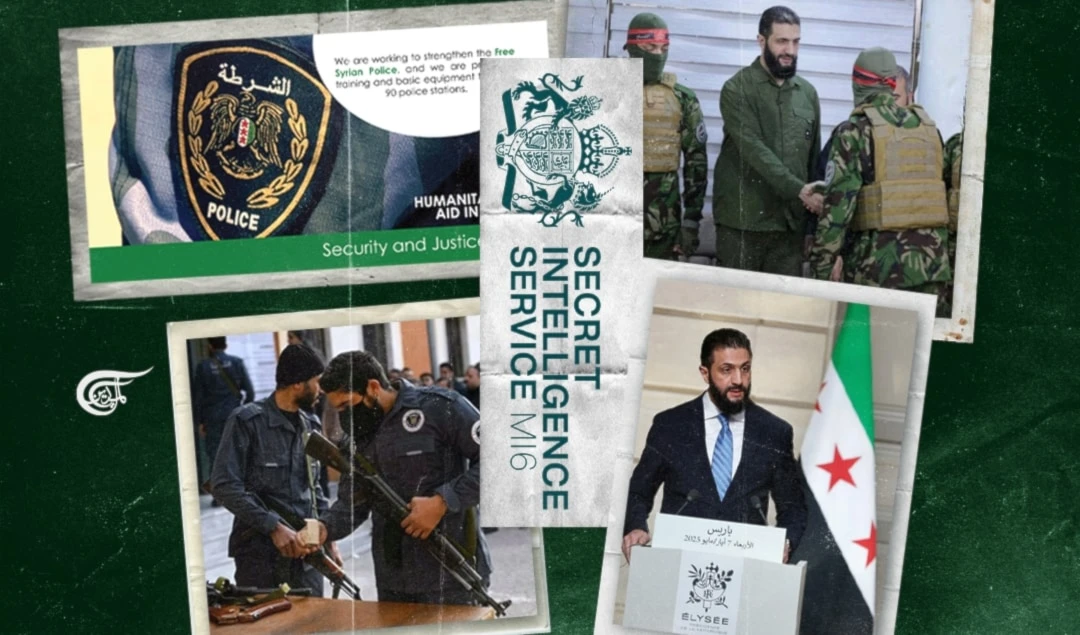Syrian Druze: A confused relationship with the new Syrian authorities
Torn between the different approaches of their religious leaders, what path will the Druze community in Syria undertake with the new Syrian administration?
-

A Druze visit to occupied Palestine that showcased two divergent approaches (Illustrated by Mahdi Rtail; Al Mayadeen English)
The Druze-majority city of Jaramana, near Damascus, has witnessed security tensions since Tuesday morning after military convoys belonging to the new administration gathered on the outskirts. This coincided with clashes involving small and medium weapons and mortar shells fired toward civilian neighborhoods, resulting in multiple civilian deaths and injuries.
This came after the spread of an audio recording attributed to Druze Sheikh Marwan Kiwan, inciting sectarian strife.
Popular discontent spread to the streets of several Syrian provinces and to universities in Damascus, Aleppo, and Homs against Druze students, who immediately left for Suweida.
Sheikh Kiwan swiftly appeared in a video denying any connection to the offensive clip, urging viewers to compare his voice with that of the man inciting violence in the fabricated recording. He also addressed all Syrians, calling for calm, restraint, and unity to prevent the country from sliding into civil war.
At the time of writing, movement in Jaramana remains virtually non-existent, with shops closed, amid fears of renewed clashes as military convoys remain stationed around the city.
The Druze community, divided into several religious leaderships, is experiencing a state of fragmented visions, in light of serious challenges imposed by the current circumstances.
The "Akl Sheikhdom" (Sheikhdom of the Mind) in Suweida is a spiritual body and hereditary religious leadership. The status of sheikhs is hereditary, and the sheikhdom cannot be named beyond three families (al-Hajri, al-Jarbou, and al-Hanawi).
Sheikh Al-Hajri's religious standing is confined to the northern, eastern, and western countryside of Sweida (Dar Qanawat). He is supported by political factions and movements such as the Suweida Military Council, the Syrian Brigade Party, and the Syrian Federal Current.
Sheikh Hamoud al-Hanawi's influence extends to the southern countryside of the governorate.
Sheikh Youssef al-Jarbou is responsible for the sect's headquarters at the Ain al-Zaman shrine, and his religious influence is concentrated in the city of Suweida and the surrounding small villages.
The two sheikhs are supported by the Men of Dignity Movement and other factions, such as Ahrar Jabal al-Arab and Liwa al-Jabal, as well as the National Forces Alliance in Suweida.
Al-Hajri maintains direct contact with Europe and communicates regularly with the spiritual leader of the Druze community in occupied Palestine, Muwaffaq Tarif, which implies indirect contact with the leadership of the Israeli occupation.
He had previously accepted the entry of aid from "Israel" into the villages of Mount Hermon, claiming it was provided by the Druze of Palestine. This completely contradicts statements made by Israeli Foreign Minister Gideon Sa'ar, who said that "Israel" was the one sending the aid.
Sheikhs al-Jarbou' and al-Hanawi, who refused any contact with Sheikh Muwaffaq Tarif, argued that the Druze were not weak enough to seek assistance from anyone, referring to "Israel". They emphasized that weapons were intended to defend oneself and one's land, not to attack anyone, and that their acquisition was temporary and that the time had not yet come to be handed over.
Local sources believe that the shift in the position of the two sheikhs (who had previously supported the new administration) stems from the sectarian massacres that took place on the Syrian coast last March.
In addition, Damascus recruited 800 members of the Sunni Arab tribes residing in Suweida to join the army and public security forces, in preparation for their deployment in the province after the Druze began to refrain from going to recruitment centers.
Both al-Jarbou and al-Hanawi consider this move as an attempt by Damascus to circumvent the idea of forming security and military forces from Suweida local residents and to consolidate the notion of "unified identity" (one color).
On the other hand, in the first visit of its kind since the fall of President Bashar al-Assad's regime, a delegation of Druze from Mount Hermon, who shares kinship ties with the residents of the Golan Heights and northern Palestine, traveled to the occupied territories last March to visit the shrine of the Prophet Shu'ayb amid heightened security and a strict ban on journalists approaching.
According to local sources, "The visit was approved by Sheikh Hikmat al-Hajri, who didn’t consider the delegation's entry into the occupied Golan Heights as a sign of normalization with Israel." He did not heed requests from religious and community figures in Suweida to prevent the visit, which was scheduled to include 100 people. However, 40 figures from Suweida Governorate decided not to participate in the visit, following pressure from prominent figures.
The sources added, "There was a popular desire to intercept the convoy and prevent it from entering through the town of Hadar, but the town's notables intervened to prevent such a move, fearing it would escalate into direct clashes with the Israeli army."
The local religious and social leaders simply issued a statement on behalf of the town's residents, condemning the visit, which came "in response to an invitation from parties loyal to the occupation." They noted that "Israel, which has never been concerned about the rights of minorities, is exploiting this religious visit, using it as a tool to sow division within the national ranks. This visit is seeking to use the Druze community as a defensive line in order to achieve Israeli expansionist interests in southern Syria." They added, "We have not and will not forget the crimes and violations committed by the occupying state against our people in the Golan Heights, the West Bank, and the Gaza Strip, emphasizing that those sheikhs represent only themselves" and that "the only affiliation of the people and families of the village of Hadar is to the Syrian people's sect."
In late April, another delegation of more than 680 clerics from Suweida, the Damascus countryside, and Mount Hermon once again visited the shrine of the Prophet Shu'ayb in the occupied territories. Although this visit was met with widespread popular opposition from Druze notables other than sheikhs, who tried to dissuade them, the insistence of Sheikh Muwaffaq Tarif, the sheikh of the community in occupied Palestine, prevented this.
The visit was approved by the spiritual leader of the community in Syria, Sheikh Hikmat al-Hajri, who avoided direct participation for reasons related to "the internal political situation in Syria." Sheikhs Youssef al-Jarbou and Youssef al-Hanawi, however, expressed their rejection of the visit "to avoid it being used by supporters of the Syrian government to distort the image of the Druze public by accusing them of collaborating with the occupying entity."
At the same time, a number of clerics, dignitaries, and activists from Suweida addressed an open letter to the head of the Syrian administration, Ahmad al-Sharaa, urging him to reconsider the constitutional declaration, which "falls short of the aspirations of the Syrian people."
They called for "the necessity of preserving the country's cultural and ethnic diversity within the framework of Syrian territorial integrity."
The signatories also expressed concern over the escalation of sectarian rhetoric on social media platforms, calling for the "formation of a national unity government" and warning against "individual dealings with external parties outside the purview of state institutions."
The letter was signed by representatives of various societal and military groups in Suweida, including sheikhs al-Hanawi and al-Jarbou, while Sheikh Hikmat al-Hajri was not among the signatories.
The author of the letter, Ziad Abu Hamdan, stated that they had received a response and was under consideration, without providing further details.

 Katia Ibrahim
Katia Ibrahim
 7 Min Read
7 Min Read










